2021 TOYOTA YARIS HATCHBACK weight
[x] Cancel search: weightPage 155 of 568
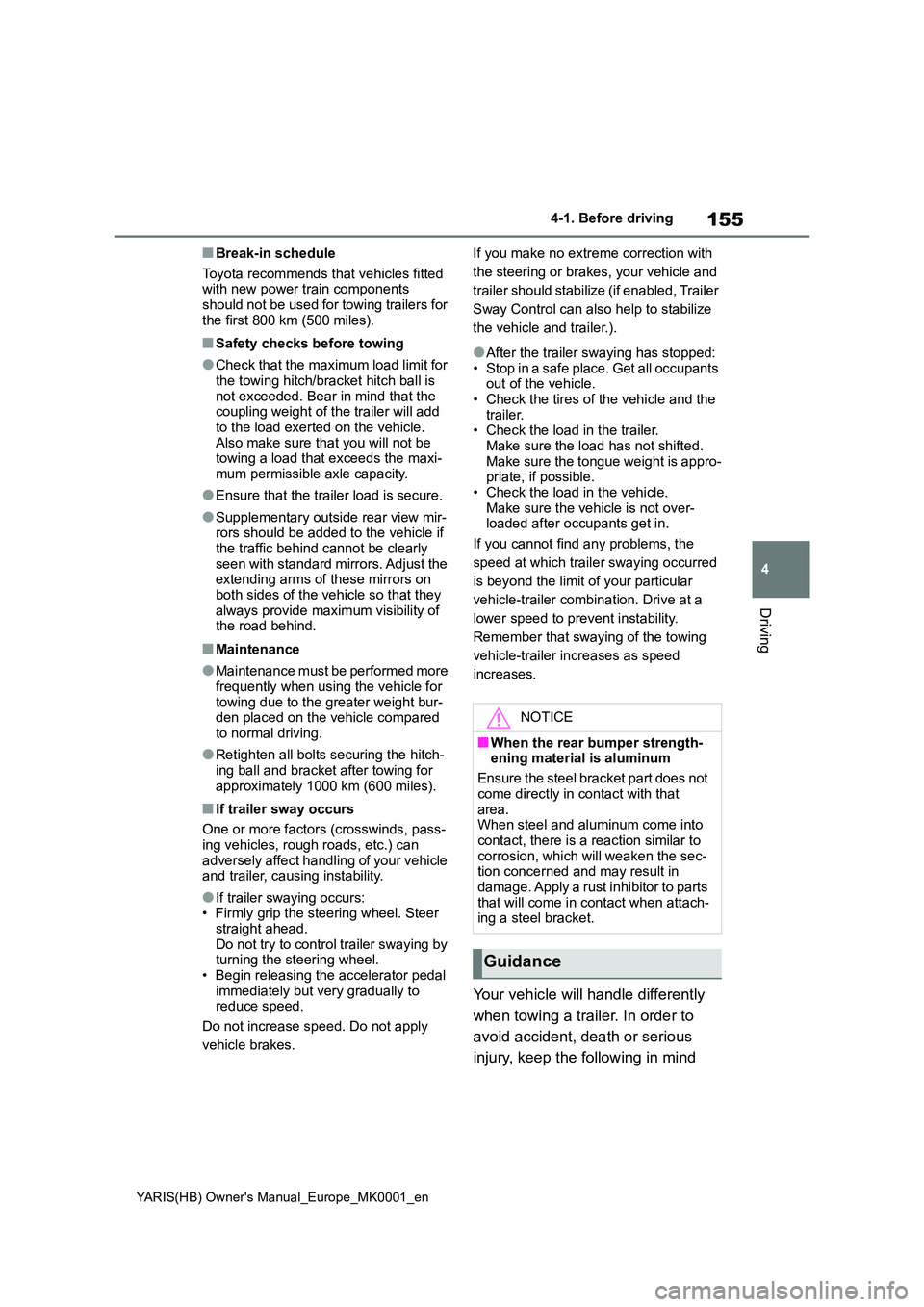
155
4
YARIS(HB) Owner's Manual_Europe_MK0001_en
4-1. Before driving
Driving
■Break-in schedule
Toyota recommends that vehicles fitted with new power train components should not be used for towing trailers for
the first 800 km (500 miles).
■Safety checks before towing
●Check that the maximum load limit for
the towing hitch/bracket hitch ball is not exceeded. Bear in mind that the coupling weight of the trailer will add
to the load exerted on the vehicle. Also make sure that you will not be towing a load that exceeds the maxi-
mum permissible axle capacity.
●Ensure that the trailer load is secure.
●Supplementary outside rear view mir- rors should be added to the vehicle if
the traffic behind cannot be clearly seen with standard mirrors. Adjust the extending arms of these mirrors on
both sides of the vehicle so that they always provide maximum visibility of the road behind.
■Maintenance
●Maintenance must be performed more frequently when using the vehicle for
towing due to the greater weight bur- den placed on the vehicle compared to normal driving.
●Retighten all bolts securing the hitch-ing ball and bracket after towing for
approximately 1000 km (600 miles).
■If trailer sway occurs
One or more factors (crosswinds, pass- ing vehicles, rough roads, etc.) can
adversely affect handling of your vehicle and trailer, causing instability.
●If trailer swaying occurs:• Firmly grip the steering wheel. Steer straight ahead.
Do not try to control trailer swaying by turning the steering wheel.• Begin releasing the accelerator pedal
immediately but very gradually to reduce speed.
Do not increase speed. Do not apply
vehicle brakes.
If you make no extreme correction with
the steering or brakes, your vehicle and
trailer should stabilize (if enabled, Trailer
Sway Control can also help to stabilize
the vehicle and trailer.).
●After the trailer swaying has stopped: • Stop in a safe place. Get all occupants out of the vehicle.
• Check the tires of the vehicle and the trailer.• Check the load in the trailer.
Make sure the load has not shifted. Make sure the tongue weight is appro-priate, if possible.
• Check the load in the vehicle. Make sure the vehicle is not over-loaded after occupants get in.
If you cannot find any problems, the
speed at which trailer swaying occurred
is beyond the limit of your particular
vehicle-trailer combination. Drive at a
lower speed to prevent instability.
Remember that swaying of the towing
vehicle-trailer increases as speed
increases.
Your vehicle will handle differently
when towing a trailer. In order to
avoid accident, death or serious
injury, keep the following in mind
NOTICE
■When the rear bumper strength- ening material is aluminum
Ensure the steel bracket part does not
come directly in contact with that area.When steel and aluminum come into
contact, there is a reaction similar to corrosion, which will weaken the sec-tion concerned and may result in
damage. Apply a rust inhibitor to parts that will come in contact when attach-ing a steel bracket.
Guidance
Page 157 of 568

157
4
YARIS(HB) Owner's Manual_Europe_MK0001_en
4-1. Before driving
Driving
■Transmission information
Multidrive
To maintain engine braking effi-
ciency and charging system perfor-
mance when using engine braking,
do not use the transmission in D,
must be in M and select gear step 4
or lower. ( →P.164)
Manual transmission
Refrain from driving in 6th gear to
maintain the effectiveness of
engine braking and to maintain
charging system performance.
■If the engine overheats
Towing a loaded trailer up a long,
steep incline in temperatures
exceeding 30°C (85°F) may result
in the engine overheating. If the
engine coolant temperature gauge
indicates that the engine is over-
heating, turn the air conditioning off
immediately, leave the road and
stop the vehicle in a safe place.
( →P.405)
■When parking the vehicle
Always place wheel chocks under
the wheels of both the vehicle and
trailer. Firmly set the parking brake
and shift the shift lever to P (Multid-
rive) and 1 or R (manual transmis-
sion).
WARNING
Follow all the instructions described in
this section. Failure to do so could cause an accident resulting in death or serious injury.
■Trailer towing precautions
When towing, make sure that none of the weight limits are exceeded.
( →P.153)
■Vehicle speed in towing
Observe the legal maximum speeds for trailer towing.
■Before descending hills or long declines
Reduce speed and downshift. How-
ever, never downshift suddenly while descending steep or long downhill grades.
■Operation of the brake pedal
Do not hold the brake pedal
depressed often or for long periods of time. Doing so may result in the brake overheating or reduce braking effects.
■To avoid accident or injury
●Vehicles with a compact spare tire:
Do not tow a trailer when the com- pact spare tire is installed on your vehicle.
●Vehicles with the emergency tire puncture repair kit: Do not tow a
trailer when the tire installed is repaired with the emergency tire puncture repair kit.
●Vehicles with a Dynamic radar cruise control: Do not use dynamic
radar cruise control when you are towing.
NOTICE
■Do not directly splice trailer
lights
Directly splicing trailer lights may damage your vehicle’s electrical sys-
tem and cause a malfunction.
Page 334 of 568
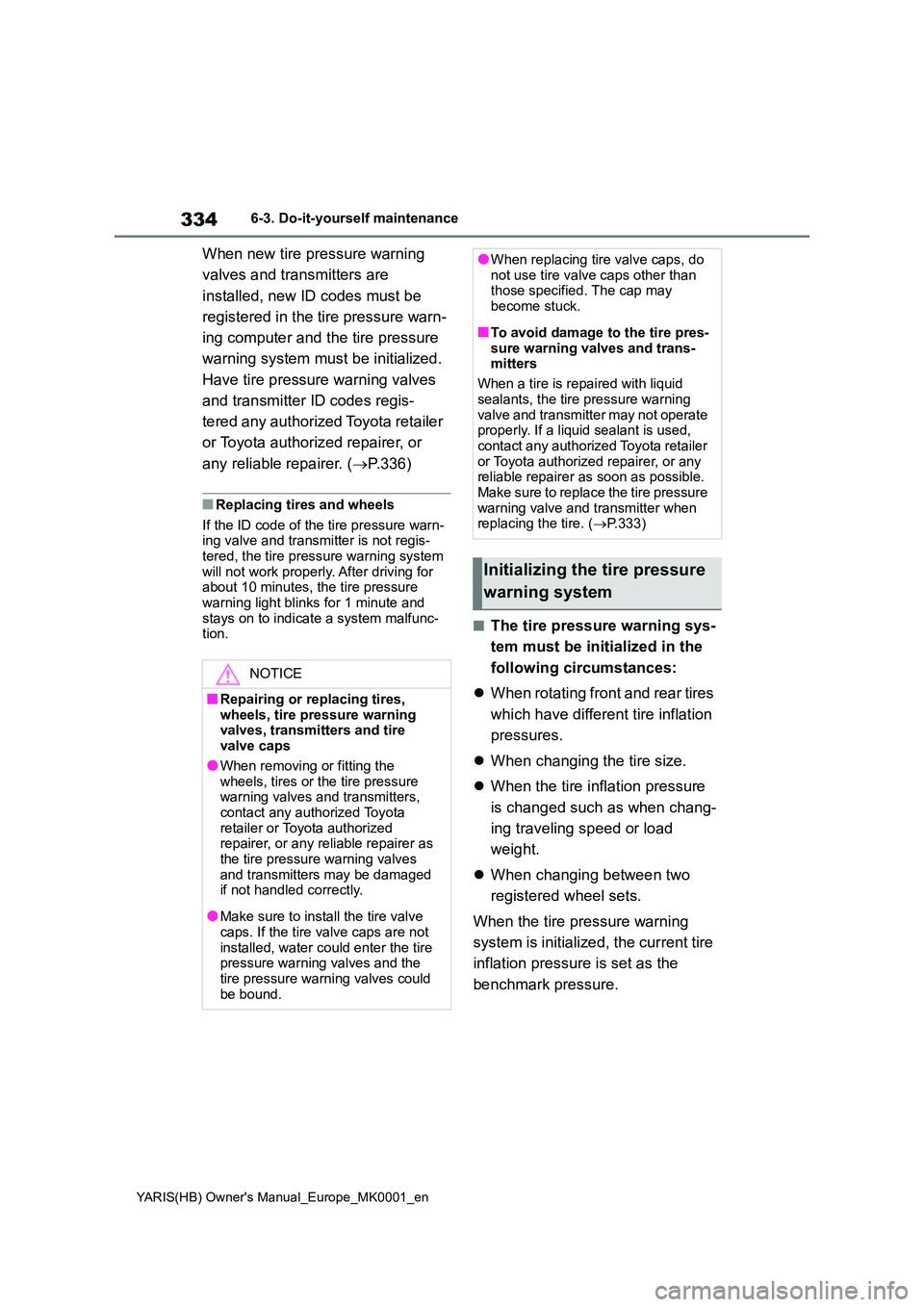
334
YARIS(HB) Owner's Manual_Europe_MK0001_en
6-3. Do-it-yourself maintenance
When new tire pressure warning
valves and transmitters are
installed, new ID codes must be
registered in the tire pressure warn-
ing computer and the tire pressure
warning system must be initialized.
Have tire pressure warning valves
and transmitter ID codes regis-
tered any authorized Toyota retailer
or Toyota authorized repairer, or
any reliable repairer. ( →P.336)
■Replacing tires and wheels
If the ID code of the tire pressure warn- ing valve and transmitter is not regis-tered, the tire pressure warning system
will not work properly. After driving for about 10 minutes, the tire pressure warning light blinks for 1 minute and
stays on to indicate a system malfunc- tion.■The tire pressure warning sys-
tem must be initialized in the
following circumstances:
�z When rotating front and rear tires
which have different tire inflation
pressures.
�z When changing the tire size.
�z When the tire inflation pressure
is changed such as when chang-
ing traveling speed or load
weight.
�z When changing between two
registered wheel sets.
When the tire pressure warning
system is initialized, the current tire
inflation pressure is set as the
benchmark pressure.
NOTICE
■Repairing or replacing tires,
wheels, tire pressure warning valves, transmitters and tire valve caps
●When removing or fitting the wheels, tires or the tire pressure warning valves and transmitters,
contact any authorized Toyota retailer or Toyota authorized repairer, or any reliable repairer as
the tire pressure warning valves and transmitters may be damaged if not handled correctly.
●Make sure to install the tire valve caps. If the tire valve caps are not
installed, water could enter the tire pressure warning valves and the tire pressure warning valves could
be bound.
●When replacing tire valve caps, do not use tire valve caps other than those specified. The cap may
become stuck.
■To avoid damage to the tire pres-
sure warning valves and trans- mitters
When a tire is repaired with liquid
sealants, the tire pressure warning valve and transmitter may not operate properly. If a liquid sealant is used,
contact any authorized Toyota retailer or Toyota authorized repairer, or any reliable repairer as soon as possible.
Make sure to replace the tire pressure warning valve and transmitter when replacing the tire. ( →P.333)
Initializing the tire pressure
warning system
Page 340 of 568
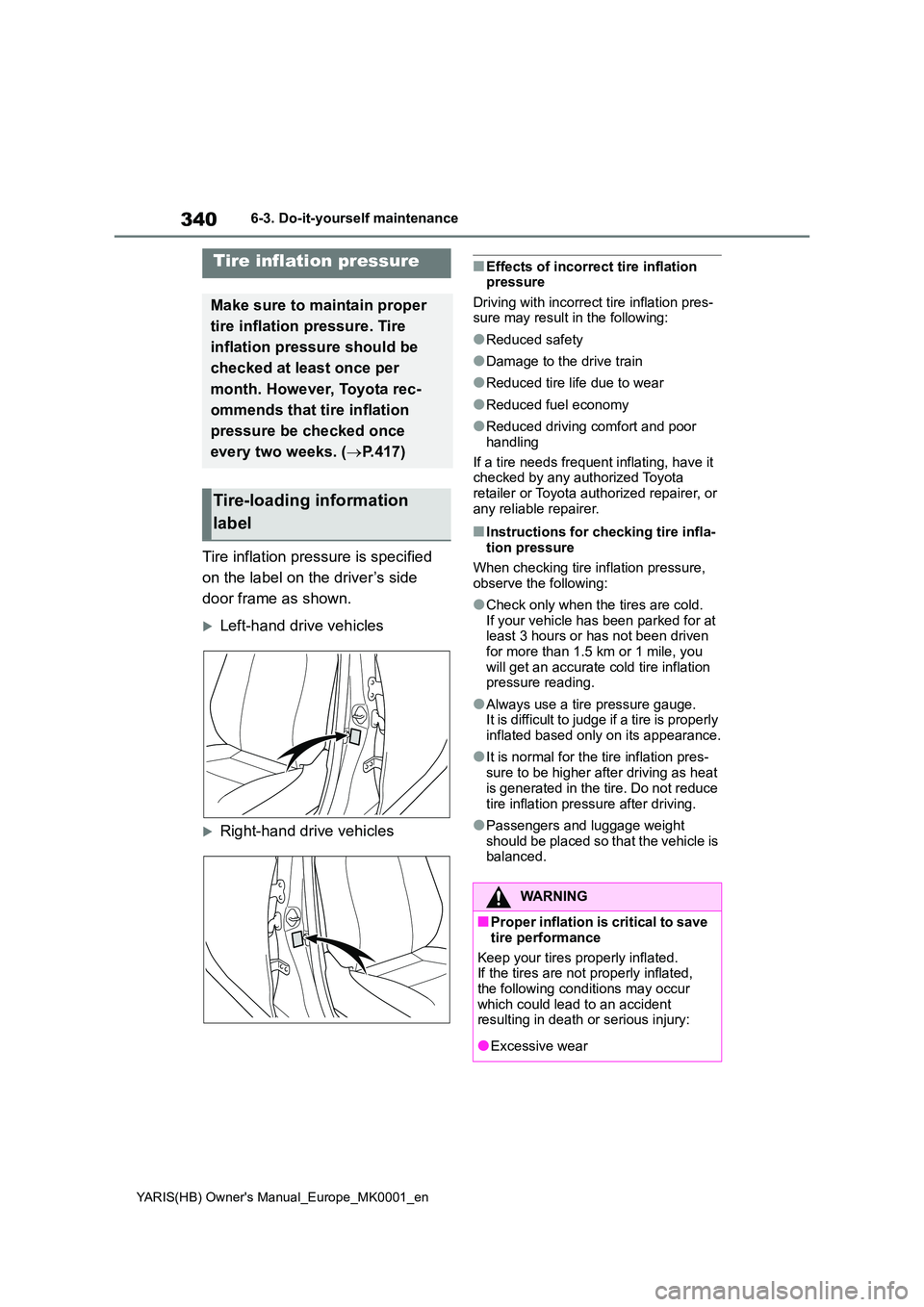
340
YARIS(HB) Owner's Manual_Europe_MK0001_en
6-3. Do-it-yourself maintenance
Tire inflation pressure is specified
on the label on the driver’s side
door frame as shown.
Left-hand drive vehicles
Right-hand drive vehicles
■Effects of incorrect tire inflation pressure
Driving with incorrect tire inflation pres- sure may result in the following:
●Reduced safety
●Damage to the drive train
●Reduced tire life due to wear
●Reduced fuel economy
●Reduced driving comfort and poor
handling
If a tire needs frequent inflating, have it checked by any authorized Toyota
retailer or Toyota authorized repairer, or any reliable repairer.
■Instructions for checking tire infla-tion pressure
When checking tire inflation pressure, observe the following:
●Check only when the tires are cold.If your vehicle has been parked for at least 3 hours or has not been driven
for more than 1.5 km or 1 mile, you will get an accurate cold tire inflation pressure reading.
●Always use a tire pressure gauge.It is difficult to judge if a tire is properly
inflated based only on its appearance.
●It is normal for the tire inflation pres-
sure to be higher after driving as heat is generated in the tire. Do not reduce
tire inflation pressure after driving.
●Passengers and luggage weight
should be placed so that the vehicle is balanced.
Tire inflation pressure
Make sure to maintain proper
tire inflation pressure. Tire
inflation pressure should be
checked at least once per
month. However, Toyota rec-
ommends that tire inflation
pressure be checked once
every two weeks. ( →P.417)
Tire-loading information
label
WARNING
■Proper inflation is critical to save
tire performance
Keep your tires properly inflated. If the tires are not properly inflated,
the following conditions may occur which could lead to an accident resulting in death or serious injury:
●Excessive wear
Page 343 of 568

343
6
YARIS(HB) Owner's Manual_Europe_MK0001_en
6-3. Do-it-yourself maintenance
Maintenance and care
�zWhen rotating, repairing or
changing your tires, check that
the wheel nuts are still tight after
driving 1600 km (1000 miles).
�zBe careful not to damage the
aluminum wheels when using
tire chains.
�zUse only Toyota genuine balance
weights or equivalent and a plas-
tic or rubber hammer when bal-
ancing your wheels.1Turn the engine switch off.
2Open the glove box. Slide off
the damper.
3Push in the glove box on the
vehicle’s outer side to discon-
nect the 2 claws. Then pull out
the glove box and disconnect
the lower claws.Air conditioning filter
The air conditioning filter must
be changed regularly to main-
tain air conditioning efficiency.
Removing the air condition-
ing filter
Page 410 of 568
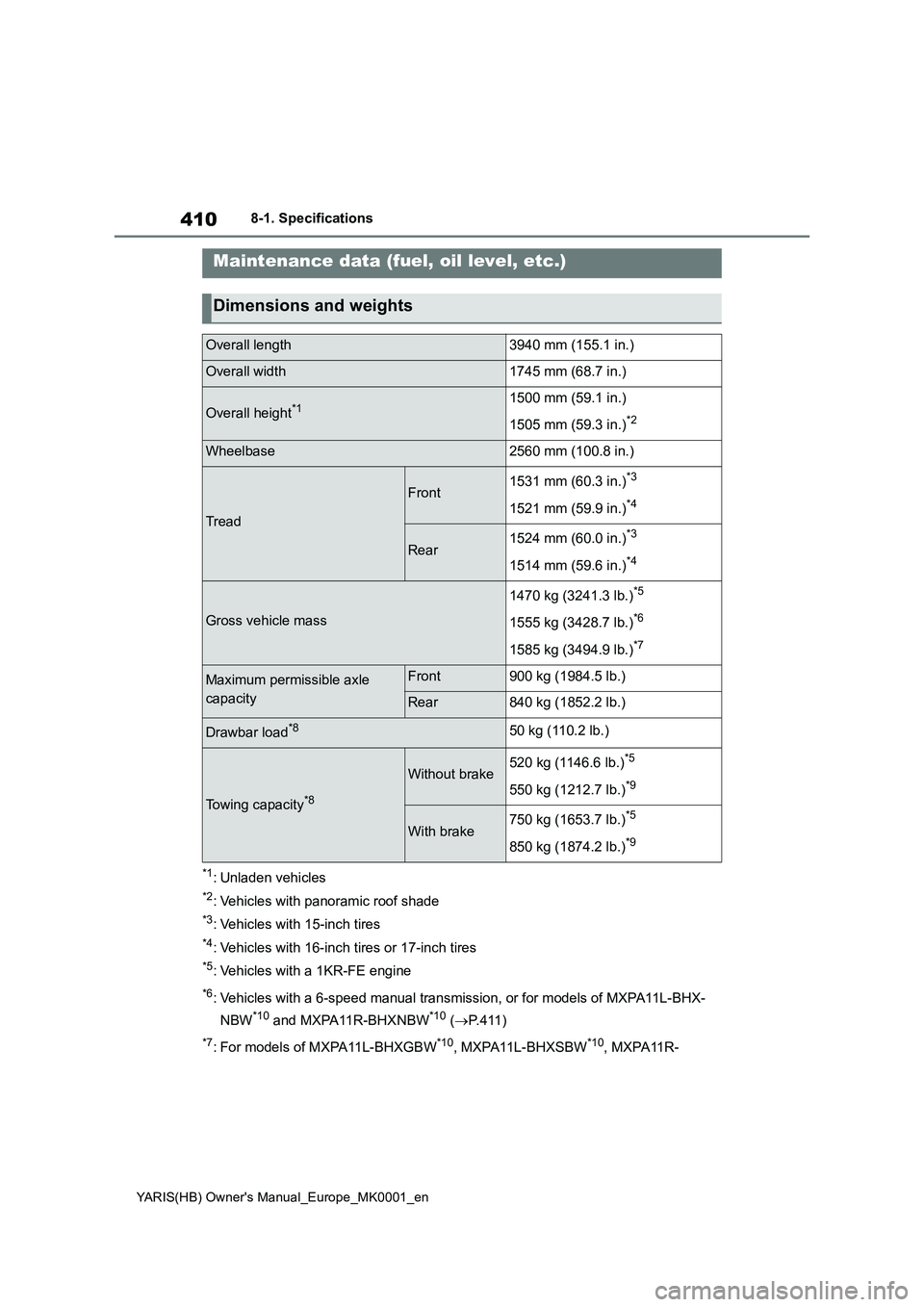
410
YARIS(HB) Owner's Manual_Europe_MK0001_en
8-1. Specifications
8-1.Spec ific ations
*1: Unladen vehicles
*2: Vehicles with panoramic roof shade
*3: Vehicles with 15-inch tires
*4: Vehicles with 16-inch tires or 17-inch tires
*5: Vehicles with a 1KR-FE engine
*6: Vehicles with a 6-speed manual transmission, or for models of MXPA11L-BHX-
NBW
*10 and MXPA11R-BHXNBW*10 (→P. 4 1 1 )
*7: For models of MXPA11L-BHXGBW*10, MXPA11L-BHXSBW*10, MXPA11R-
Maintenance data (fuel, oil level, etc.)
Dimensions and weights
Overall length3940 mm (155.1 in.)
Overall width1745 mm (68.7 in.)
Overall height*11500 mm (59.1 in.)
1505 mm (59.3 in.)
*2
Wheelbase2560 mm (100.8 in.)
Tread
Front1531 mm (60.3 in.)*3
1521 mm (59.9 in.)*4
Rear1524 mm (60.0 in.)*3
1514 mm (59.6 in.)*4
Gross vehicle mass
1470 kg (3241.3 lb.)*5
1555 kg (3428.7 lb.)*6
1585 kg (3494.9 lb.)*7
Maximum permissible axle
capacityFront900 kg (1984.5 lb.)
Rear840 kg (1852.2 lb.)
Drawbar load*850 kg (110.2 lb.)
Towing capacity*8
Without brake520 kg (1146.6 lb.)*5
550 kg (1212.7 lb.)*9
With brake750 kg (1653.7 lb.)*5
850 kg (1874.2 lb.)*9
Page 431 of 568
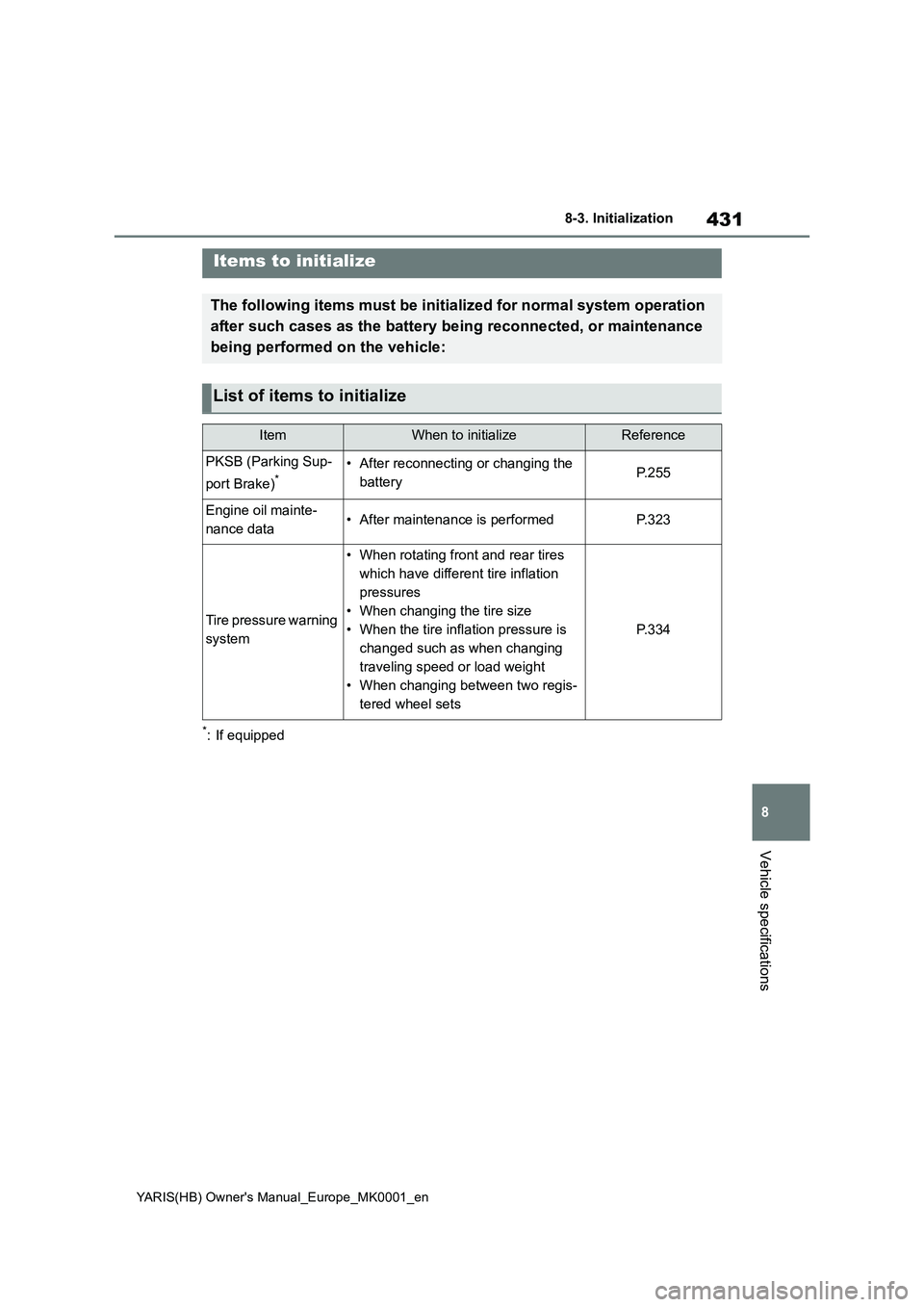
431
8
YARIS(HB) Owner's Manual_Europe_MK0001_en
8-3. Initialization
Vehicle specifications
8- 3. In it ia li za ti on
*: If equipped
Items to initialize
The following items must be initialized for normal system operation
after such cases as the battery being reconnected, or maintenance
being performed on the vehicle:
List of items to initialize
ItemWhen to initializeReference
PKSB (Parking Sup-
port Brake)
*• After reconnecting or changing the
batteryP. 2 5 5
Engine oil mainte-
nance data• After maintenance is performedP. 3 2 3
Tire pressure warning
system
• When rotating front and rear tires
which have different tire inflation
pressures
• When changing the tire size
• When the tire inflation pressure is
changed such as when changing
traveling speed or load weight
• When changing between two regis-
tered wheel sets
P. 3 3 4
Page 565 of 568

565
YARIS(HB) Owner's Manual_Europe_MK0001_en
Alphabetical Index
Multidrive.................................... 164
Paddle shift switches ................. 166
TRC (Traction Control) ................. 269
Trip meters ................................ 87, 91
Turn signal lights .......................... 171
Replacing light bulbs .......... 351, 352
Turn signal lever ........................ 171
Wattage ...................................... 419
V
Vanity lights .................................. 303
Wattage ...................................... 419
Vanity mirrors ............................... 303
Vehicle data recording ..................... 7
Vehicle identification number...... 411
Vehicle information display ... 97, 102
Vehicle Stability Control (VSC).... 268
Vehicle Stability Control+ (VSC+) 268
VSC (Vehicle Stability Control).... 268
VSC+ (Vehicle Stability Control+) 268
W
Warning buzzers
Approach warning ...................... 219
Brake Override System .............. 370
Brake system ............................. 368
Downshifting .............................. 168
Drive-Start Control ..................... 370
Electric power steering............... 370
Engine ........................................ 369
High coolant temperature........... 368
Key reminder.............................. 159
Low engine oil pressure ............. 369
LTA (Lane Tracing Assist) .. 203, 372
Open door .......................... 117, 119
PCS (Pre-Collision System) ....... 374
PKSB (Parking Support Brake) .. 373
RCTA (Rear Crossing Traffic Alert)
......................................... 248, 373
Seat belt ..................................... 371SRS airbag ................................. 369
Stop & Start system ................... 372
Tire pressure .............................. 372
Toyota parking assist-sensor.... 242,
373
Warning lights ............................... 368
ABS ............................................ 369
Brake Override System .............. 370
Brake system .............................368
Charging system ........................ 368
Drive-Start Control ..................... 370
Electric power steering ............... 370
High coolant temperature ........... 368
Low engine oil pressure ............. 369
Low fuel level .............................371
LTA indicator ............................... 372
Malfunction indicator lamp ......... 369
PKSB OFF indicator ................... 373
Pre-collision system ................... 374
RCTA OFF indicator ................... 373
Seat belt reminder light .............. 371
Slip indicator............................... 374
SRS airbag ................................. 369
Stop & Start cancel indicator ...... 372
Tire pressure .............................. 372
Toyota parking assist-sensor OFF
indicator ...................................373
Warning messages .......................377
Washer ........................................... 181
Checking .................................... 329
Preparing and checking before win-
ter ............................................. 274
Switch......................................... 181
Washing and waxing .................... 308
Weight ............................................ 410
Wheels ........................................... 341
Replacing ...................................341
Size ............................................ 417
Window lock switch...................... 141
Windows
Power windows .......................... 139